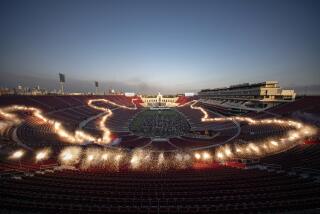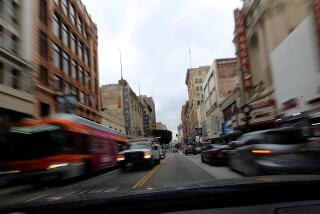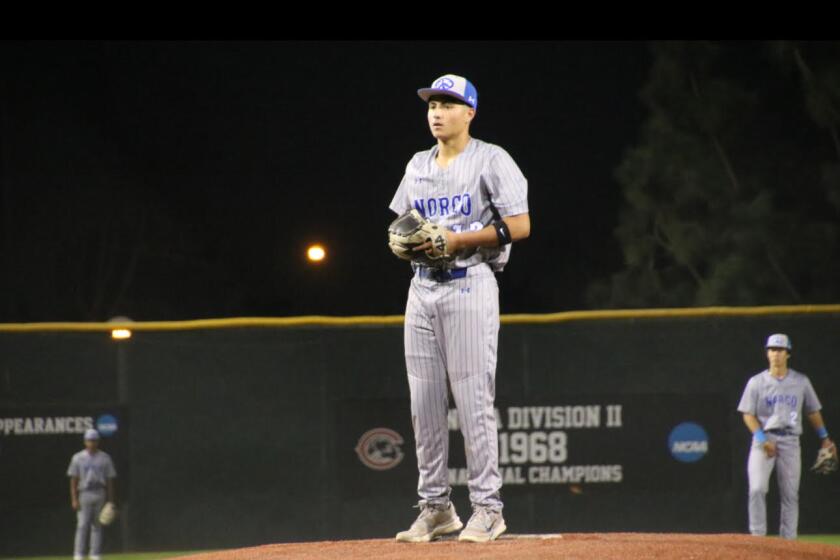Officials Vouch for Coliseum Press Box Safety
- Share via
The Los Angeles Memorial Coliseum’s new press box is safe and spectators should have no concerns about sitting under the structure, the engineer and the inspection firm president who oversaw the work told officials Wednesday.
Earlier in the day, both for the first time formally certified that the structural-steel press box contains no defects that would jeopardize its stability. The facility has been in use since the fall, 1995, college football season.
“In my opinion the structure is safe to occupy, and I . . . have not witnessed any defects that would jeopardize the stability of the press box,” Nabih Youssef, the structural engineer whose firm designed the facility and oversaw its construction, said in a letter to the Coliseum Commission.
The certifications came just hours before an exhibition soccer match scheduled at the Coliseum, where the press box hangs over more than 600 seats.
The facility’s welds have been subjected to testing since Monday, in response to a Times article that reported difficulties encountered during construction with the welded connections.
James E. Partridge, president of the inspection firm, Smith-Emery Co., said at a meeting of the Coliseum Commission that the testing will continue over at least the next several days. Partridge said no cracks have been detected.
In an interview afterward, Partridge said that he does not know what the new ultrasound testing being conducted by his inspectors has found, because it is being “controlled” by a Seattle company.
Most of the Coliseum commissioners who spoke at the meeting said they would welcome a suggestion by county Supervisor Zev Yaroslavsky for an independent review, perhaps conducted by university professors. Yaroslavsky said he would not be satisfied until a group of experts without a direct stake in the original work provides an evaluation.
“I, as one member of the commission, will not leave it at just these individuals [who spoke at Wednesday’s meeting] and their hired hands to pass muster over this,” Yaroslavsky said afterward. “They all have a stake in this, both professionally and public safety-wise. Only the commission has a stake in this, public safety-wise, alone. And I think we need to reassure ourselves and the public.”
Partridge, Youssef and another engineer from his firm, Brent Nuttall, stressed that they were satisfied that adequate repairs were made at a San Bernardino-area steel shop to any welds that cracked during construction.
Moreover, they said that they do not believe that the presence of “delayed cracking” during the shop welding should cause any concern about the quality of welds in the press box that do not have observable flaws.
Partridge also stood by his firm’s decision not to inform the structural engineer who dealt most closely with the construction that inspectors observed delayed cracking during the shop welding. The inspection firm president said that all possible efforts were made to reinspect and repair any cracks.
Partridge, the two engineers and the project’s lead architect were questioned for about an hour by Don C. Webb, who had been hired by the commission to oversee the construction last year. Webb at one point asked them if they, without reservation, would allow their children or their grandchildren to sit beneath the facility. Each said they would.
Webb repeatedly criticized the Times account, saying it has raised concerns unnecessarily.
“We are faced with the task of disproving that there is a fire in the theater,” Webb said.
He assailed people quoted in the Times account, including a Caltech engineer, John F. Hall. Toward the end of the three-hour session, Hall told the commission that he remains concerned about the quality of the press box welds, despite the repairs.
“My concerns about the press box remain,” said Hall, who led an independent review of damage inflicted on buildings during the 1994 Northridge earthquake.
The Times article reported that Smith-Emery kept in its private files the inspectors’ observations of delayed cracking and other problems, including the snapping at the welding shop of a so-called “wing plate” joint important to the support of the press box.
For his part, Partridge, who also is a civil engineer, said that problems were encountered during the welding of “four or five” wing plates. Any cracking, he said, was repaired and the pieces are sound.
Partridge reiterated that his company did not inform the structural engineer of these difficulties at the shop because the company performing the work, San Bernardino Steel, made all necessary repairs.
Partridge also was critical of the newspaper article. He said that a retired inspector quoted in it had told him that a group of 41 welds, identified as rejected on a Smith-Emery report, had shown no evidence of flaws. Partridge said the inspector related that the 41 had been rejected because they were being shipped early from the shop and would require testing with ultrasound when they arrived at the Coliseum.
The retired inspector, Cecil Farrar, denied Wednesday night that he told Partridge any such thing.
“I didn’t tell him that,” Farrar said, adding that Partridge had not asked him about the 41 welds. Regarding those welds, Farrar said: “They were either cracked or had slag inclusions” or some other form of defect. “They were rejectable.”
The welds were not identified as having been repaired on the June 30, 1995, inspection document. Partridge said at Wednesday’s meeting that he believes the welds, as installed, are sound, based on a review of records of the structure as it was assembled in the field and a conversation with a Smith-Emery inspector who worked at the Coliseum site last year.
Partridge, who had earlier told the Times that the delayed cracking observed by his inspectors during the shop welding of the press box was out of the ordinary, told the commission Wednesday that what occurred was not abnormal. As for the overall volume of cracking with the work, Partridge said: “We had a low percentage of rejections, overall, on the job.”
Partridge said at the meeting that inspectors over the past few days have attempted to verify whether there is any problem with a welded connection that inspector Farrar and a welding shop foreman had told The Times they suspected might be cracked. The two had said that they had heard a sound, called “rifling,” which they suspected might have indicated a crack existed that they could not see or detect with ultrasound.
Partridge said that, based on what inspectors have now found, he is convinced there is no crack. “It’s our experience that rifling would be very unusual in such a connection,” Partridge said.
Farrar said Wednesday night that he disagrees with Partridge’s conclusion that rifling would be unusual in such a connection.
The project architect, Lanson Nichols, told the commission that the certifications provided by the structural engineer and the inspection firm would clear the way for obtaining a new city occupancy permit for the Coliseum that would encompass the press box.
Times staff writer Kenneth Reich contributed to this report.
More to Read
Go beyond the scoreboard
Get the latest on L.A.'s teams in the daily Sports Report newsletter.
You may occasionally receive promotional content from the Los Angeles Times.











